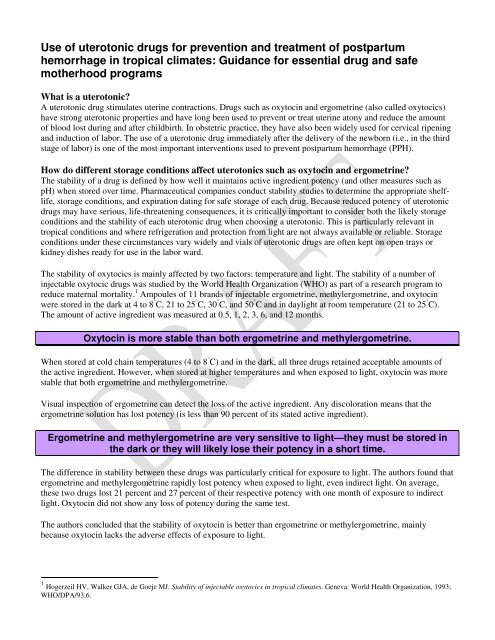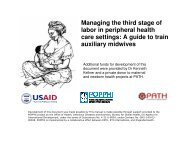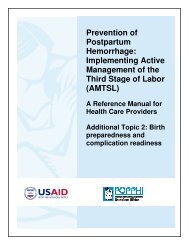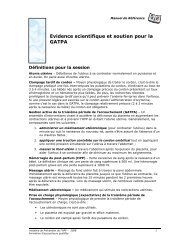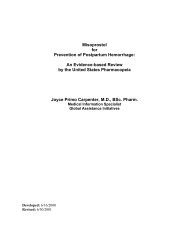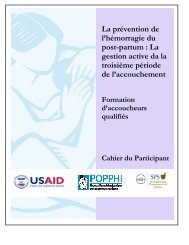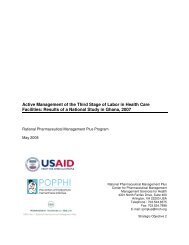Use of uterotonic drugs for prevention and treatment of postpartum ...
Use of uterotonic drugs for prevention and treatment of postpartum ...
Use of uterotonic drugs for prevention and treatment of postpartum ...
You also want an ePaper? Increase the reach of your titles
YUMPU automatically turns print PDFs into web optimized ePapers that Google loves.
<strong>Use</strong> <strong>of</strong> <strong>uterotonic</strong> <strong>drugs</strong> <strong>for</strong> <strong>prevention</strong> <strong>and</strong> <strong>treatment</strong> <strong>of</strong> <strong>postpartum</strong><br />
hemorrhage in tropical climates: Guidance <strong>for</strong> essential drug <strong>and</strong> safe<br />
motherhood programs<br />
What is a <strong>uterotonic</strong><br />
A <strong>uterotonic</strong> drug stimulates uterine contractions. Drugs such as oxytocin <strong>and</strong> ergometrine (also called oxytocics)<br />
have strong <strong>uterotonic</strong> properties <strong>and</strong> have long been used to prevent or treat uterine atony <strong>and</strong> reduce the amount<br />
<strong>of</strong> blood lost during <strong>and</strong> after childbirth. In obstetric practice, they have also been widely used <strong>for</strong> cervical ripening<br />
<strong>and</strong> induction <strong>of</strong> labor. The use <strong>of</strong> a <strong>uterotonic</strong> drug immediately after the delivery <strong>of</strong> the newborn (i.e., in the third<br />
stage <strong>of</strong> labor) is one <strong>of</strong> the most important interventions used to prevent <strong>postpartum</strong> hemorrhage (PPH).<br />
How do different storage conditions affect <strong>uterotonic</strong>s such as oxytocin <strong>and</strong> ergometrine<br />
The stability <strong>of</strong> a drug is defined by how well it maintains active ingredient potency (<strong>and</strong> other measures such as<br />
pH) when stored over time. Pharmaceutical companies conduct stability studies to determine the appropriate shelflife,<br />
storage conditions, <strong>and</strong> expiration dating <strong>for</strong> safe storage <strong>of</strong> each drug. Because reduced potency <strong>of</strong> <strong>uterotonic</strong><br />
<strong>drugs</strong> may have serious, life-threatening consequences, it is critically important to consider both the likely storage<br />
conditions <strong>and</strong> the stability <strong>of</strong> each <strong>uterotonic</strong> drug when choosing a <strong>uterotonic</strong>. This is particularly relevant in<br />
tropical conditions <strong>and</strong> where refrigeration <strong>and</strong> protection from light are not always available or reliable. Storage<br />
conditions under these circumstances vary widely <strong>and</strong> vials <strong>of</strong> <strong>uterotonic</strong> <strong>drugs</strong> are <strong>of</strong>ten kept on open trays or<br />
kidney dishes ready <strong>for</strong> use in the labor ward.<br />
The stability <strong>of</strong> oxytocics is mainly affected by two factors: temperature <strong>and</strong> light. The stability <strong>of</strong> a number <strong>of</strong><br />
injectable oxytocic <strong>drugs</strong> was studied by the World Health Organization (WHO) as part <strong>of</strong> a research program to<br />
reduce maternal mortality. 1 Ampoules <strong>of</strong> 11 br<strong>and</strong>s <strong>of</strong> injectable ergometrine, methylergometrine, <strong>and</strong> oxytocin<br />
were stored in the dark at 4 to 8 ° C, 21 to 25 ° C, 30 ° C, <strong>and</strong> 50 ° C <strong>and</strong> in daylight at room temperature (21 to 25 ° C).<br />
The amount <strong>of</strong> active ingredient was measured at 0.5, 1, 2, 3, 6, <strong>and</strong> 12 months.<br />
Oxytocin is more stable than both ergometrine <strong>and</strong> methylergometrine.<br />
When stored at cold chain temperatures (4 to 8 ° C) <strong>and</strong> in the dark, all three <strong>drugs</strong> retained acceptable amounts <strong>of</strong><br />
the active ingredient. However, when stored at higher temperatures <strong>and</strong> when exposed to light, oxytocin was more<br />
stable that both ergometrine <strong>and</strong> methylergometrine.<br />
Visual inspection <strong>of</strong> ergometrine can detect the loss <strong>of</strong> the active ingredient. Any discoloration means that the<br />
ergometrine solution has lost potency (is less than 90 percent <strong>of</strong> its stated active ingredient).<br />
Ergometrine <strong>and</strong> methylergometrine are very sensitive to light—they must be stored in<br />
the dark or they will likely lose their potency in a short time.<br />
The difference in stability between these <strong>drugs</strong> was particularly critical <strong>for</strong> exposure to light. The authors found that<br />
ergometrine <strong>and</strong> methylergometrine rapidly lost potency when exposed to light, even indirect light. On average,<br />
these two <strong>drugs</strong> lost 21 percent <strong>and</strong> 27 percent <strong>of</strong> their respective potency with one month <strong>of</strong> exposure to indirect<br />
light. Oxytocin did not show any loss <strong>of</strong> potency during the same test.<br />
The authors concluded that the stability <strong>of</strong> oxytocin is better than ergometrine or methylergometrine, mainly<br />
because oxytocin lacks the adverse effects <strong>of</strong> exposure to light.<br />
1 Hogerzeil HV, Walker GJA, de Goeje MJ. Stability <strong>of</strong> injectable oxytocics in tropical climates. Geneva: World Health Organization, 1993;<br />
WHO/DPA/93.6.
Table 1: Results <strong>of</strong> simulation studies on the stability <strong>of</strong> oxytocics under tropical conditions<br />
Active ingredient <strong>of</strong> injectable oxytocic <strong>drugs</strong> after one year <strong>of</strong> controlled storage<br />
Br<strong>and</strong>s Batches Mean active ingredient after 12 months storage<br />
Dark, 4-8 ° C Dark, 30 ° C Light, 21-25 ° C<br />
Ergometrine 4 8 5% loss 31% loss 90% loss<br />
Methylergometrine 4 8 4% loss 18% loss 90% loss<br />
Oxytocin 3 6 0% loss 14% loss 7% loss<br />
Values are mean percentage <strong>of</strong> potency loss based on initial amount <strong>of</strong> active ingredient. 2<br />
Selecting a Uterotonic<br />
What are the differences in cost<br />
The prices <strong>of</strong> generic ergometrine <strong>and</strong> oxytocin are similar, <strong>and</strong> both are relatively inexpensive.<br />
Are there differences in manufacturers<br />
Yes. There are considerable differences between products <strong>of</strong> different manufacturers. There<strong>for</strong>e, it is important to<br />
carefully select the supplier <strong>and</strong> conduct frequent quality control measures.<br />
What about the cold chain during transport <strong>and</strong> storage<br />
The WHO study also concluded that up to two week exposure to temperatures <strong>of</strong> 40 ° C or one month at 30 ° C during<br />
transport would not seriously affect the potency <strong>of</strong> any <strong>of</strong> the <strong>drugs</strong>. There<strong>for</strong>e, brief unrefrigerated transport from<br />
overseas suppliers or from a central store within country should not significantly affect the potency <strong>of</strong> injectable<br />
oxytocics. In case refrigerated storage is not available, oxytocin <strong>and</strong> ergometrine may be temporarily stored outside<br />
the refrigerator <strong>for</strong> a maximum <strong>of</strong> three months, at not more than 30 ° C.<br />
Recommendations <strong>for</strong> Selection <strong>of</strong> Injectable Uterotonic Drugs<br />
Due to its increased effectiveness, better stability, fewer contraindications <strong>and</strong> side effects, <strong>and</strong> equal cost, WHO<br />
recommends oxytocin as the drug <strong>of</strong> choice <strong>for</strong> management <strong>of</strong> the third stage <strong>of</strong> labor in developing countries. If<br />
oxytocin is not available, ergometrine may be used, as long as it is carefully stored in dark conditions.<br />
Oxytocin<br />
Ergometrine<br />
Efficacy Very effective Effective<br />
Response time Acts in 2 to 3 minutes Acts in 6 to 7 minutes<br />
Cost Inexpensive Inexpensive<br />
Route <strong>of</strong> administration Injection Injection<br />
Side effects Minimal Nausea <strong>and</strong> vomiting possible<br />
Contraindications*<br />
(<strong>postpartum</strong> use)<br />
None<br />
Retained placenta, pre-eclampsia,<br />
eclampsia, <strong>and</strong> hypertension<br />
Storage Cold storage (2 to 8 ° C) Cold storage (2 to 8 ° C)<br />
Protect from light<br />
Stability More stable than ergometrine Very unstable in light, less thermo-stable<br />
than oxytocin<br />
*List <strong>of</strong> contraindications is not meant to be complete; evaluate each client <strong>for</strong> drug sensitivities <strong>and</strong> appropriateness prior to<br />
the use <strong>of</strong> any drug. Only some <strong>of</strong> the major contraindications <strong>for</strong> <strong>postpartum</strong> use are listed <strong>for</strong> the above <strong>drugs</strong>.<br />
2 Hogerzeil HV, Walker G. Instability <strong>of</strong> (methyl)ergometrine in tropical climates: an overview. European Journal <strong>of</strong> Obsetrics &<br />
Gynecology <strong>and</strong> Reproductive Biology. 1996;69:25–29.
Flow Chart <strong>for</strong> Selecting Oxytocic Drugs<br />
If both <strong>drugs</strong><br />
available<br />
Refrigerator<br />
(2-8 ° C)<br />
NO<br />
STORAGE*<br />
Locations:<br />
• Central drug stores<br />
• Labor/delivery unit<br />
• Postpartum unit<br />
During transport<br />
LIGHT<br />
OXYTOCIN<br />
Y<br />
E<br />
S<br />
D<br />
A<br />
R<br />
K<br />
Contraindications<br />
to ergometrine<br />
Contraindications<br />
to ergometrine<br />
YES<br />
OXYTOCIN<br />
Y<br />
E<br />
S<br />
NO<br />
N<br />
O<br />
OXYTOCIN<br />
OXYTOCIN<br />
OR<br />
ERGOMETRINE**<br />
*Storage:<br />
• Keep in closed cupboards or clean supply areas.<br />
• Keep vials in closed box until ready <strong>for</strong> use.<br />
• Keep out <strong>of</strong> light (including away from windows <strong>and</strong> sunlight).<br />
• Dispense/keep adequate, accessible supply on labor/delivery <strong>and</strong> <strong>postpartum</strong> wards.<br />
• Check ergometrine <strong>for</strong> any discoloration, since that indicates a loss <strong>of</strong> potency <strong>of</strong> drug.<br />
• Ensure storage in a cool, dark area during transport <strong>of</strong> <strong>drugs</strong>, if possible.<br />
• Ensure that all relevant staff are in<strong>for</strong>med <strong>of</strong> guidelines on storage <strong>of</strong> <strong>uterotonic</strong>s.<br />
**WHO recommends the use <strong>of</strong> ergometrine only if oxytocin is not available.
Guidelines <strong>for</strong> the storage <strong>of</strong> oxytocin <strong>and</strong> ergometrine<br />
If there is:<br />
A cold chain<br />
• During transit from manufacturer<br />
• During transit in-country<br />
No cold chain<br />
• No reliable or consistent means <strong>of</strong> keeping<br />
<strong>drugs</strong> at required temperature during transit<br />
A refrigerator upon arrival at facility<br />
• Reliable, working refrigeration<br />
• Able to keep a constant temperature <strong>of</strong><br />
2 to 8 ° C<br />
• Sufficient space in the refrigerator to store<br />
oxytocics<br />
Do the following:<br />
1. Keep oxytocics at 2 to 8 ° C.<br />
2. Keep in the dark whenever possible.<br />
Oxytocin is not light sensitive, but it is still good practice<br />
to store it in the dark, if possible.<br />
Ergometrine must be kept in the dark at all times; it loses<br />
potency very quickly when exposed to light.<br />
1. Keep <strong>drugs</strong> in the dark, away from light during transit.<br />
If kept in the dark, <strong>drugs</strong> may be exposed <strong>for</strong> up to 2<br />
weeks at no more than 40°C while in transit.<br />
1. Store oxytocics at 2 to 8 ° C.<br />
2. Keep ampoules/vials in a closed box away from light.<br />
3. Periodically remove ample amount needed <strong>for</strong> expected<br />
client load from refrigerator.<br />
4. Ergometrine ampoules/vials that are removed from<br />
refrigerator must be kept in the dark, out <strong>of</strong> any light.<br />
5. Oxytocin ampoules/vials that are removed from the<br />
refrigerator can be kept in either light or dark; however,<br />
the best practice is to keep in the dark.<br />
No refrigerator upon arrival at facility<br />
• No electricity<br />
• No reliable refrigeration<br />
• Not sufficient room in existing refrigerator<br />
to store oxytocics<br />
• No refrigeration at all<br />
1. Keep <strong>drugs</strong> in closed boxes/cartons if possible. Remove<br />
vials/ampoules only when ready <strong>for</strong> use.<br />
2. Keep adequate oxytocics <strong>and</strong> supplies available<br />
(needles/syringes) in labor <strong>and</strong> delivery/<strong>postpartum</strong><br />
units at all times.<br />
3. Store <strong>drugs</strong> in the dark, away from light.<br />
Ergometrine is very light sensitive <strong>and</strong> loses potency<br />
quickly in the light. It must be stored in dark at all times.<br />
4. Consider rotation <strong>of</strong> oxytocic <strong>drugs</strong> in <strong>and</strong> out <strong>of</strong> the<br />
refrigerator if space not sufficient to store entire stock.<br />
Oxytocin <strong>and</strong> ergometrine may be stored outside the<br />
refrigerator at 30°C or less <strong>for</strong> not more than 3 months.<br />
Oxytocin is more stable than ergometrine, <strong>and</strong> oxytocin is not sensitive to light. WHO recommends<br />
oxytocin as the drug <strong>of</strong> choice <strong>for</strong> active management <strong>of</strong> the third stage <strong>of</strong> labor <strong>and</strong> advises that<br />
ergometrine only be used when oxytocin is not available.<br />
Other related reading: Hogerzeil HV, Walker GJA. Oxytocin more stable in tropical climates (letter). British Medical Journal.<br />
1994;308:59.


